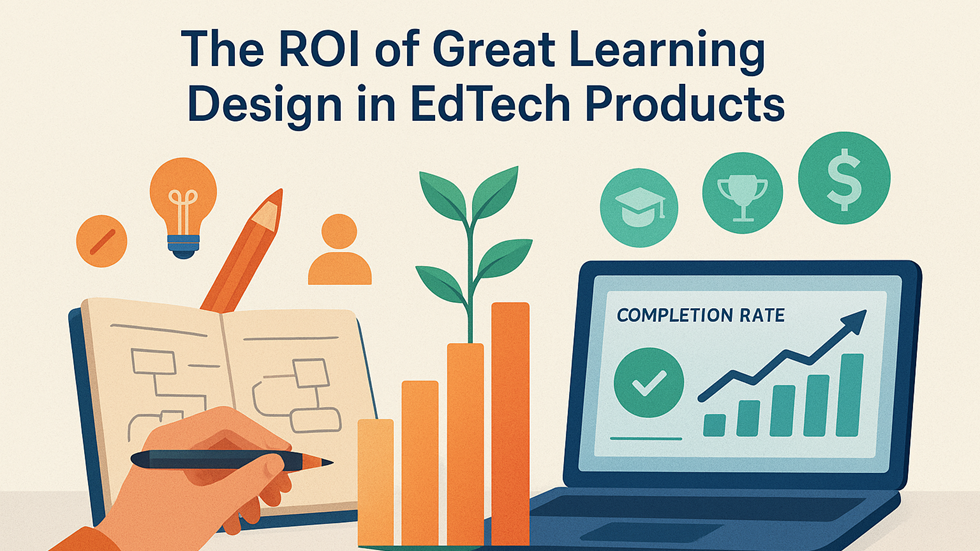
The ROI of Great Learning Design in EdTech Products – EdTechReview
Have you ever noticed how some EdTech products look amazing but don’t actually teach anything meaningful? Slick UX, gamified dashboards, shiny integrations, but when you look at learner data, completion rates are low, retention is slipping, and engagement drops after week two. Here’s the thing… It’s not about the tech. It’s about design… Learning design!
Across hundreds of studies and real-world examples, the evidence tells a clear story:
When EdTech teams design with the learner in mind, ROI increases. Completion rates improve by up to 30%, revenue rises by nearly 25%, and companies can see returns of over 327% within six months of launch (Coursera for Business, 2025).
To learn a learner-centric learning design process, check out this video:
So, let’s unpack what that really means and why learning design is not a cost centre, but your greatest growth strategy.
How thoughtful Learning Design increases engagement and retention
Think about the last course you didn’t finish. Was it the topic or the experience?
Good learning design makes learning sticky. It’s what turns a one-time user into a lifelong learner. Coursera’s research found that optimised courses (around four weeks long, short video content, hands-on activities) achieve 55.4% completion rates compared to industry averages that hover under 20% (Coursera’s Drivers of Quality report, 2020).
The design details matter:
- Videos under 10 minutes? 16% higher completion
- In-browser activities? 20% more learners finishing
- Social learning moments (like discussion forums)? 25% boost in engagement
And when you get that early engagement right, particularly in the first two weeks, completion nearly doubles (Coursera’s Drivers of Quality report, 2020).
Adaptive learning also has a measurable edge. By adjusting to a learner’s progress in real time, adaptive systems cut time-to-competency by 40–60% (Codebridge Tech, 2024) and improve knowledge retention by up to 75% compared to passive formats (Byju’s, 2024).
Design, not luck, drives those outcomes.
The financial ROI of Learning Design
What does great learning design mean for your bottom line?
When done well, learning design pays for itself. Corporate programs that prioritise structure, feedback, and active learning achieve an average ROI of 327%, with a payback period of less than six months (Forrester’s Total Economic Impact Study for Coursera).
And it’s not just internal training. Digital learning products in the edtech space are generating 353% ROI (about $4.53 for every $1 invested) (Illumina Interactive’s analysis).
Add accessibility and usability improvements to the mix, and you could see $100 back for every $1 spent (BOIA, 2024).
Yes, accessibility is now a business strategy, not just a compliance line item.
Companies that invest in accessible, inclusive learning design see 23–28% revenue increases within a few years. That’s not a coincidence. That’s design driving growth.
Learning outcomes Are business outcomes
We used to talk about learner outcomes as a “nice to have.” Not anymore.
When 91% of learners on well-designed platforms report positive career outcomes and 46% report salary increases (Coursera Learner Outcomes Report, 2025). That becomes a brand story.
Think about it:
- 73% of completers say their course directly led to professional benefits.
- 27% gained higher-level job roles.
- 71% of unemployed learners found jobs within six months of completing their programs.
These stats are marketing gold. They build trust, retention, and word-of-mouth growth.
Proven examples of EdTech success powered by Learning Design
Duolingo: Engagement by design
With over 500 million users, Duolingo are masters at the art of learning design.
Their streak feature alone increases two-week retention by 14%, and microlearning keeps learners 75% more motivated than in traditional classrooms (Scrimmage, 2024).
Every design choice, from adaptive content to feedback loops, reinforces habit formation (Health Matters & Me, 2024).
Coursera: Scaling quality
Coursera’s “Quality Framework” distils learning science into measurable design principles:
- Engagement
- Satisfaction
- Skill development
- Career outcomes
Courses that apply all four are six times more likely to achieve learner success.
With 70 million learners worldwide, this isn’t theory, but proof that pedagogy and profit go hand in hand.
Kahoot & Quizlet: The science of retention
Kahoot’s meta-analysis showed learning performance improved by 0.72 standard deviations. That’s the equivalent of jumping a full letter grade.
Quizlet’s studies report moderate-to-strong gains in learning (g = 0.62) and retention (g = 0.74).
Both platforms combine play with purpose, proving that interactive design can result in measurable learning and business impact.
Why accessibility and Universal Design boost ROI and reach
Accessibility is often seen as the ethical choice. It’s also the smart one.
WCAG-compliant learning environments don’t just reach more learners. They outperform others on visibility, SEO, and customer loyalty.
Accessible sites achieve 23% higher organic traffic and 27% more keyword rankings, driving ROI beyond 200% (Accessibility Works).
They also reduce support costs, expand market reach to 26% of adults with disabilities, and tap into the $548 billion discretionary spending of older users (Make It Fable, 2025).
Inclusivity scales.
How adaptive and personalised learning accelerate competency and ROI
Adaptive learning technology personalises learning for every user, and that personalisation translates directly into retention and speed.
At Arizona State University, implementing adaptive tools led to a 10% increase in student retention (Vorecol, 2024). DreamBox Learning users improved math proficiency by 25% with just 60 minutes a week (Omniplex Learning).
Students in adaptive programs consistently show 15–20% higher knowledge retention, 30% greater engagement, and up to 60% faster time-to-competence.
When design meets data, the ROI speaks for itself.
Learning Design as a strategic advantage in the evolving EdTech market
Learning design isn’t just a capability, it’s an investment category.
Between 2021 and 2025, job openings for instructional designers grew by 43%, with 6–9% annual growth projected through 2030 (TechGuide, 2025).
And organisations are backing this shift with capital: spending on external learning products jumped 23% to $12.4 billion, while global EdTech funding surpassed $1 billion in 2024 (Classter, 2024).
Companies that embed design thinking into their learning ecosystems outperform peers in engagement, satisfaction, and scalability metrics.
The data couldn’t be clearer: learning design is now a business competency.
Design is the future of ROI in education technology
From Duolingo to Coursera, from corporate learning to global EdTech, every success story has one thing in common: design that teaches.
The numbers say it all:
- 55–70% completion rates
- 30% higher skill development
- 327% ROI within six months
In a market on track to exceed $400 billion by 2029, EdTech companies can’t afford to treat learning design as optional (Grand View Research, 2025).
Because at the end of the day, when learning works, so does everything else.
If you’re looking to embed Learning Design into your offering, check Oppida’s free, on-demand webinar to understand the four hidden costs every team needs to consider when building online educational offerings. Our team has helped over 100 organisations design and deliver 250+ online courses, each built with a clear business case and measurable ROI. We’ve seen what drives profitability, what scales sustainably, and what stalls, and have distilled those lessons into this focused 8-minute session:
References
- https://about.coursera.org/press/wp-content/uploads/2020/10/Coursera_DriversOfQuality_Book_MCR-1126-V4-lr.pdf
- https://blog.coursera.org/coursera-for-business-delivers-327-roi-key-findings-from-new-forrester-total-economic-impact-study/
- https://assets.ctfassets.net/00atxywtfxvd/2eocGVEBKQlIHuLNaSuK1l/18f31949bff069d78a22daf8869566b7/2025-coursera-learner-outcomes-report.pdf
- https://www.boia.org/blog/roi-of-web-accessibility
- https://www.grandviewresearch.com/industry-analysis/education-technology-market
Source link



